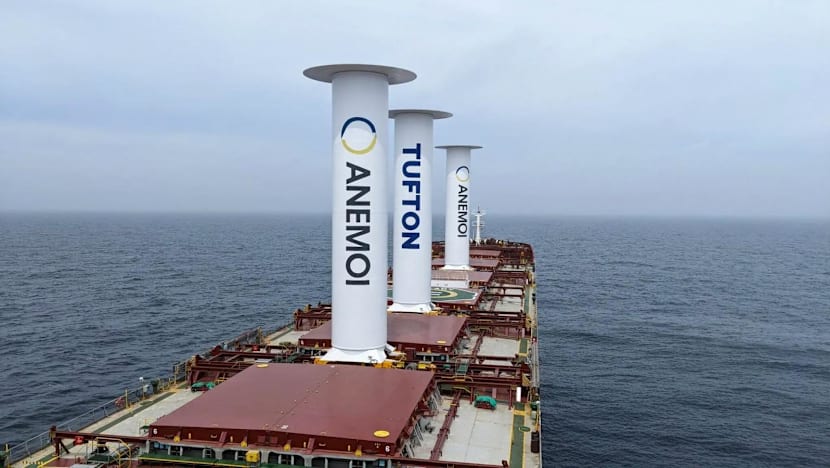UK funds efforts to curb greenhouse gases from shipping industry
The British government has pumped in millions of dollars to help startups find potential solutions to reduce maritime emissions.

A ship using rotor sails - spinning columns which pull vessels along by catching the wind - at sea. (Photo: Anemoi Marine Technologies)

This audio is generated by an AI tool.
LONDON: The shipping industry is responsible for about 3 per cent of the world’s greenhouse gases, comparable to the annual emissions of Japan.
The United Nations’ International Maritime Organization has ambitious targets to make global shipping net-zero by around 2050.
To that end, the United Kingdom has been providing millions of dollars in funding to help British startups find potential solutions.
WIND POWER
In the north of London, engineers at Anemoi Marine Technologies are developing wind propulsion technology that can power ships using less energy.
It produces rotor sails – columns of spinning cylinders that harness power from the wind to generate thrust, improving vessel efficiency.
As a result, less fuel is used, reducing the emission of harmful greenhouse gases into the atmosphere.
“A rotor sail of a certain area will give you the thrust of a traditional sail 10 times the area which, on a ship, removes all of the issues with visibility,” said Joe Plunkett, a senior engineer at Anemoi.
This is because traditional sails can be huge, obstructing the crew’s visibility. Rotor sails are much smaller and helps avoid this problem, and also provides more access to the deck and cargo space.
New funding from the British government’s Clean Maritime Demonstration Competition (CMDC) will help Anemoi’s engineers develop a folding version of the sail, as well as make aerodynamic improvements.
Its current version – undergoing testing at its facility – was developed from funds won during a previous round.
“The CMDC funding has been put to good use in allowing us to design and develop a smaller rotor sail, which is suited for smaller to medium sized ships,” said Plunkett.
“The fleet of smaller to medium-sized ships is enormous. So, that unlocks a whole new raft of vessels, which can have rotor sails installed and saves all that extra fuel.”
Its most recent at-sea trial, tested in various conditions around the world, found that running the sail saved over 9 per cent of the ship’s fuel. This could cut costs by thousands of dollars a day for the largest ships.
Experts said if each voyage made use of such wind-assist technologies, the industry could reduce its carbon dioxide emissions by as much as the equivalent of what Singapore produces per year.
GREEN ALTERNATIVES
But for the international maritime industry to achieve its carbon neutrality target by 2050, wind-assisted power alone will not be enough.
Through the CMDC, British authorities are providing millions of dollars in funding to develop other green technologies that might help put the sector on a heading for net-zero.
Academics studying how to decarbonise the shipping industry have broken the strategies down into three broad categories: Converting ships to run on electricity instead of fossil fuels, increasing efficiency using wind power, and using synthetic fuel.
Tristan Smith, a professor at University College London’s Energy Institute, said electrifying vessels is most effective for short trips.
One example is crossing the English Channel between Dover in Britain and Calais in France, which takes at least 90 minutes across about 34 km. Batteries can easily last the journey and be recharged at ports.
For longer voyages, ships will still need liquid fuel alongside electricity and wind power. Hence, a substitute to fossil fuel must be found.
Smith said he believes the best candidate for alternative fuels is ammonia, which can be put in a modified diesel ship engine, and can be burned with 1 to 2 per cent of the warming impact of a conventionally fuelled engine.
“Fundamentally, it's the cheapest way to produce a liquid fuel that is scalable and capable of meeting the 200 million tonnes of oil consumption that the sector has at the moment. And it's the cheapest to store it as well, which is very important,” he added.
However, he said challenges remain in creating the supply chain on land that could produce the vast quantities of ammonia needed, and passing the policies that will mobilise the hundreds of billions of dollars needed to do that.















